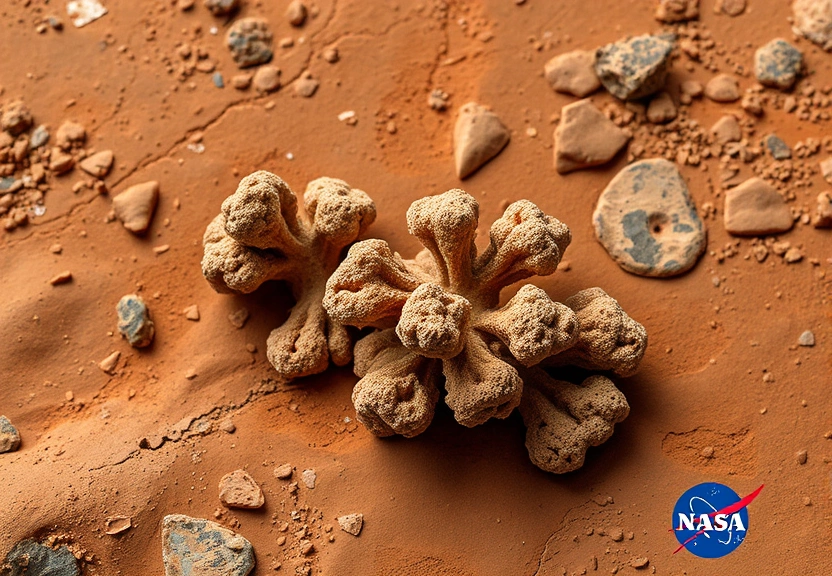Did NASA Discover Coral on Mars? Uncover the Geology Behind It!
In recent years, Mars has been a focal point for scientific exploration, leading to groundbreaking discoveries that have sparked curiosity and debate. Among these findings, images captured by NASA’s Curiosity Rover sparked a wave of interest when some formations appeared to resemble corals, marine animals known for their intricate structures. This resemblance raised questions about the possibility of life on Mars and what these formations could mean for our understanding of the planet’s geology. However, a closer examination reveals that these formations are not of biological origin but are instead geological in nature.

This article delves into the details surrounding the so-called “coral” formations on Mars, examining their geological characteristics, the process behind their formation, and the implications for future Mars exploration. By understanding these formations better, we can appreciate the complexities of Martian geology and what they reveal about the planet’s past.
The Discovery: Curiosity Rover’s Findings
The Curiosity Rover, which has been exploring the Martian surface since 2012, has provided an unprecedented look at the geology of the Red Planet. In October 2021, images taken by the rover showed unusual rock formations that bore a striking resemblance to coral. This resemblance led many to speculate about the potential for past life on Mars, drawing parallels to Earth’s marine environments.
What Did the Images Show?
The images captured by Curiosity displayed intricate, branching structures that could easily be mistaken for coral reefs found in Earth’s oceans. These features were located in the Gale Crater, an area that has been the subject of intense scrutiny due to its rich geological history. The formations’ unique shapes and patterns led scientists to investigate their origins further.
Understanding the Geology of Martian Formations
To grasp the implications of these findings, it is essential to understand the geological processes that could lead to such formations. Mars, much like Earth, has undergone significant geological transformations over millions of years, resulting in various rock types and structures. The formations that resemble corals are primarily composed of sedimentary rock, shaped by a series of geological processes.
Sedimentary Processes on Mars
On Earth, coral reefs form through biological processes, but Mars lacks the necessary conditions for such life forms. Instead, the formations observed by the Curiosity Rover are likely the result of sedimentary processes, including:
- Depositional Processes: Over time, sediment accumulates in layers, shaped by wind and water activity.
- Diagenesis: This refers to the physical and chemical changes that occur in sediments after they are deposited, leading to hardened rock formations.
- Weathering and Erosion: Mars’s harsh conditions contribute to the erosion of these rock structures, leading to the intricate shapes observed by the rover.
Why the Misinterpretation Occurred
The initial excitement surrounding the “coral” formations can be attributed to the human tendency to anthropomorphize and associate unfamiliar shapes with familiar objects. The striking resemblance to coral, combined with the allure of discovering life beyond Earth, ignited a wave of speculation. However, scientists emphasize the importance of rigorous analysis and the need to differentiate between genuine biological formations and those of geological origin.
The Role of Public Perception
Public interest in space exploration often leads to misunderstandings about scientific findings. As images of the Martian surface circulate in popular media, the potential for misinterpretation grows. This phenomenon underscores the importance of clear communication from scientists and space agencies like NASA to educate the public about the true nature of their findings.
The Implications for Mars Exploration
The discovery of formations resembling coral raises important questions about the geological history of Mars and its potential for past life. While these specific formations are not indicative of biological activity, they contribute to the broader understanding of the planet’s environmental conditions and geological processes.
Future Exploration and Research
Understanding Martian geology is crucial for future exploration missions, including potential manned missions to Mars. The information gathered from formations like the “coral” structures can help scientists develop hypotheses about the planet’s climate history and its capacity to support life. As exploration continues, researchers aim to:
- Investigate other geological formations for signs of ancient water activity.
- Analyze soil samples for organic compounds.
- Utilize advanced technology to conduct in-depth geological assessments of Martian terrain.
Frequently Asked Questions
1. Did NASA actually find coral on Mars?
No, the formations observed by the Curiosity Rover that resemble coral are geological in nature and not biological. They result from sedimentary processes on Mars.
2. What do these formations tell us about Mars’s past?
The formations suggest that Mars has experienced significant geological activity, including sediment deposition and erosion, which may indicate the past presence of water.
3. How do scientists differentiate between biological and geological formations?
Scientists analyze the physical and chemical properties of the formations, looking for evidence of organic material or processes that are characteristic of biological activity.
4. What role does the Curiosity Rover play in Mars exploration?
The Curiosity Rover is equipped with scientific instruments that allow it to analyze the Martian surface, gather data, and send back images for further study.
5. What is the significance of studying Martian geology?
Studying Martian geology helps scientists understand the planet’s history, climate, and potential for past or present life, which is crucial for future exploration missions.
Conclusion
The fascination surrounding the “coral” formations seen by NASA’s Curiosity Rover highlights the intersection of scientific discovery and public interest. While these formations are not evidence of marine life on Mars, they provide valuable insights into the planet’s geological history and the processes that have shaped its surface over millions of years. With ongoing research and exploration, our understanding of Mars continues to evolve, opening new avenues for inquiry and excitement about the possibilities that lie beyond our planet.
📰 Original Source
Este artigo foi baseado em informações de: https://super.abril.com.br/ciencia/nasa-coral-marte-entenda/